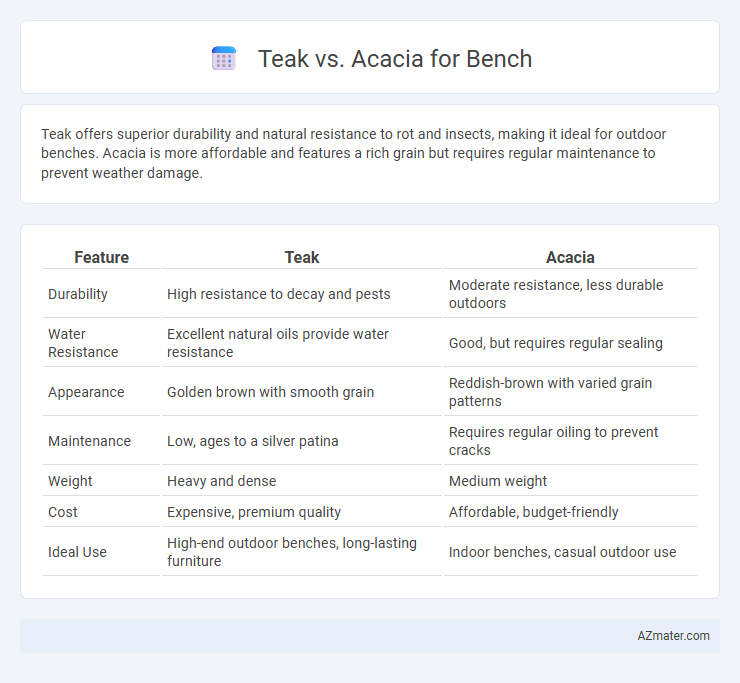Teak offers superior durability and natural resistance to rot and insects, making it ideal for outdoor benches. Acacia is more affordable and features a rich grain but requires regular maintenance to prevent weather damage.
Table of Comparison
| Feature | Teak | Acacia |
|---|---|---|
| Durability | High resistance to decay and pests | Moderate resistance, less durable outdoors |
| Water Resistance | Excellent natural oils provide water resistance | Good, but requires regular sealing |
| Appearance | Golden brown with smooth grain | Reddish-brown with varied grain patterns |
| Maintenance | Low, ages to a silver patina | Requires regular oiling to prevent cracks |
| Weight | Heavy and dense | Medium weight |
| Cost | Expensive, premium quality | Affordable, budget-friendly |
| Ideal Use | High-end outdoor benches, long-lasting furniture | Indoor benches, casual outdoor use |
Introduction: Teak vs Acacia for Benches
Teak and Acacia are popular hardwoods for benches due to their durability and natural beauty. Teak offers superior resistance to weather and insects, making it ideal for outdoor furniture, while Acacia provides a rich, warm tone with excellent strength at a more affordable price. Choosing between Teak and Acacia depends on factors like budget, maintenance, and desired aesthetic for garden or patio benches.
Overview of Teak Wood
Teak wood is renowned for its exceptional durability, natural oils, and resistance to decay, making it a top choice for outdoor benches. Its dense grain and golden-brown color enhance both longevity and aesthetic appeal, often lasting decades with minimal maintenance. Compared to acacia, teak's superior weather resistance and low susceptibility to insect damage make it a premium investment for outdoor furniture.
Overview of Acacia Wood
Acacia wood, known for its rich amber hues and natural durability, offers an attractive and cost-effective alternative to teak for bench construction. Its dense grain makes it resistant to weather and insects, ensuring long-lasting outdoor use without heavy maintenance. The sustainability of acacia, often harvested from fast-growing plantations, appeals to environmentally conscious consumers seeking durable garden furniture.
Durability Comparison: Teak vs Acacia
Teak offers exceptional durability due to its natural oils and dense grain, making it highly resistant to rot, insects, and weathering, which is ideal for outdoor benches exposed to harsh elements. Acacia wood, while durable and moderately resistant to decay, requires regular maintenance and sealing to prevent cracking and fading over time. Overall, teak benches typically outlast acacia benches by several years in outdoor settings, providing a longer-lasting investment.
Weather Resistance and Maintenance
Teak is renowned for its exceptional weather resistance due to natural oils that repel water, insects, and decay, making it ideal for outdoor benches with minimal maintenance. Acacia, while durable and moderately weather-resistant, requires regular sealing or oiling to prevent cracking and warping when exposed to harsh weather conditions. Choosing teak ensures long-lasting performance and less upkeep in variable climates compared to acacia, which demands more frequent care to maintain its appearance and structural integrity.
Aesthetic Differences
Teak benches showcase a warm golden hue that deepens into a rich amber over time, highlighting fine grain patterns and natural oils that create a smooth, lustrous finish. Acacia benches offer a more varied palette with striking contrasts between light and dark brown tones, featuring bold, irregular grain patterns that add a rustic and character-rich appearance. The distinct textures of teak's uniformity versus acacia's dynamic grain make each ideal for different aesthetic preferences in outdoor and indoor bench designs.
Cost and Affordability
Teak benches typically cost more due to the wood's durability, natural oils, and resistance to weather, making it a premium choice for outdoor furniture. Acacia benches are more affordable, offering a budget-friendly alternative with decent durability and a similar aesthetic appeal. For those prioritizing cost-effectiveness without sacrificing quality, acacia benches provide a compelling balance between price and performance.
Sustainability and Environmental Impact
Teak is highly valued for its natural oils and durability, offering long-lasting benches with less frequent replacement, which reduces resource consumption over time. Acacia grows faster and can be sourced from sustainable plantations, making it a more rapidly renewable option with lower deforestation risk. Both woods have eco-certified options like FSC, but Acacia's quicker regeneration rate often makes it a more environmentally responsible choice for sustainable bench production.
Best Applications for Each Wood Type
Teak wood is ideal for outdoor benches due to its exceptional weather resistance, natural oils that repel insects, and high durability, making it perfect for garden or patio furniture exposed to sun and rain. Acacia is best suited for indoor or covered bench applications where its attractive grain and affordability shine, offering moderate durability but requiring protection from constant moisture. Both woods provide sturdy, long-lasting benches, but teak excels in harsh outdoor environments while acacia is excellent for decorative, controlled settings.
Conclusion: Choosing the Right Wood for Your Bench
Teak offers superior durability, natural resistance to weather and pests, and a rich golden hue that deepens with age, making it ideal for long-lasting outdoor benches. Acacia, while more affordable and featuring a warm, reddish-brown tone, requires regular maintenance to prevent cracking and fading, which may suit indoor or sheltered bench placements better. Selecting the right wood depends on your budget, maintenance commitment, and the bench's exposure to outdoor elements, with teak being the premium choice for longevity and minimal upkeep.

Infographic: Teak vs Acacia for Bench
 azmater.com
azmater.com